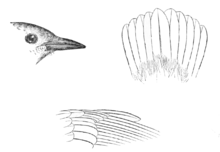Antillean piculet
The Antillean piculet (Nesoctites micromegas) is a species of bird in the woodpecker family Picidae. It is monotypic within the genus Nesoctites. The species is evolutionarily distinct from the other piculets and is afforded its own subfamily Nesoctitinae.[2] It is endemic to the Caribbean island of Hispaniola (Dominican Republic and Haiti). A fossil feather in amber attributed to the genus has been found in the Dominican Republic, showing that the ancestors of the species have been isolated on Hispaniola for at least 25 mya.[3]
| Antillean piculet | |
|---|---|
_(8082816234).jpg) | |
| Scientific classification | |
| Kingdom: | Animalia |
| Phylum: | Chordata |
| Class: | Aves |
| Order: | Piciformes |
| Family: | Picidae |
| Subfamily: | Nesoctitinae |
| Genus: | Nesoctites Hargitt, 1890 |
| Species: | N. micromegas |
| Binomial name | |
| Nesoctites micromegas (Sundevall, 1866) | |

Habitat
The Antillean piculet occupies a number of different habitats within Hispaniola, including humid and dry Pinus and broadleaf forests, as well as semi-arid scrubland and thorn-forest.[4] It will also occupy stands of mangrove forest and occasionally orchards and plantations. It occurs from sea level to 1800 m, although in pine forests it is more common below 300 m. Within this habitat it prefers dense undergrowth.
Description
The species is a small woodpecker, although it is twice as large as any of the other piculets, measuring around 14–16 cm and weighing around 30 g.[4] The male has a yellow crown with a red spot in the centre. The plumage of the back, neck and wings is olive green, and the breast, throat and belly is off-white with streaks and spots. The female is similar to the male, except larger and lacking the red spot on the forecrown. The plumage of juvenile birds is similar to the adults but duller. Unlike the true woodpeckers (Picinae), they do not drum on trees to advertise their ownership of a territory, instead calling in a loud and rapid whistle. This call, rendered as "kuk-kikikikekukuk",[4] is also used as a contact call between pairs.
Diet and behavior
The Antillean piculet feeds on insects, with ants and beetles forming a large part of the diet.[4] They also consume a lot of fruit compared to other piculets. Individuals and pairs forage rapidly through the understory of their habitat, mostly on small branches, twigs, vines and stalks, and less commonly on trunks. Food is mostly obtained by gleaning, with a few weak pecks (but no hammering as found in the true woodpeckers). The breeding season of the Antillean piculet is March to July. A cavity is excavated in a stump, tree, palm or fence post in which two to four eggs are laid. The pair are highly territorial and will aggressively call and display towards intruders.
References
- BirdLife International (2012). "Nesoctites micromegas". IUCN Red List of Threatened Species. 2012. Retrieved 26 November 2013.CS1 maint: ref=harv (link)
- Benz, Brett W.; Robbins, Mark B.; Peterson, A. Townsend (2006). "Evolutionary history of woodpeckers and allies (Aves: Picidae): Placing key taxa on the phylogenetic tree". Molecular Phylogenetics and Evolution. 40 (2): 389–399. doi:10.1016/j.ympev.2006.02.021. PMID 16635580.
- Grimaldi, David A.; Case, Gerard Ramon (1995). "A feather in amber from the Upper Cretaceous of New Jersey" (PDF). American Museum Novitates. 3126: 1–6.
- Winkler H & D. Christied (2002) "Family Picidae (Woodpeckers)" in el Hoyo, J.; Elliot, A. & Sargatal, J. (editors). (2002). Handbook of the Birds of the World. Volume 7: Jacamars to Woodpeckers. Lynx Edicions. Pg. 436 ISBN 84-87334-37-7
